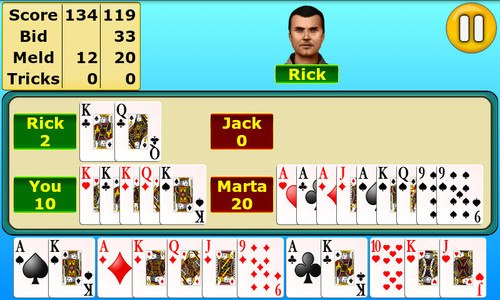


The high bidder gets to pick up the cards in the kiddy and decide if they want to trade them with cards in their existing hand, discarding the cards they don’t want to use. Often in Cutthroat Pinochle, and in some variations of Partner Pinochle, the Kitty is used to give the high bidder an opportunity to strengthen their hand. When all but one players pass, the remaining player wins the bidding. The bidding goes around clockwise, and each player must decide to either raise the bid by the bidding increment or pass. The player to the left of the dealer is the first to place a bid or may choose to pass. There is usually a minimum starting bid and a set bidding increment that all players agree to before the game begins. However, if a player over-bids and fails to make their bid amount by the end of the hand, they will be penalized by losing the amount of points wagered and forfeiting any points earned in that hand.Īfter all cards are dealt, players pick up their hand and must evaluate how many points they think they might earn. The highest bidder gets honor of choosing the Trump suit, and often gets to either pass cards with their partner or take cards from the kitty to form a better hand. Most variations of Pinochle involve a bidding phase in which players wager on how many points they believe they can earn by the end of the hand. However, in Cutthroat, often the last set of cards (3 cards in single-deck, or 5 cards in double deck) are placed face-down on the table into the “kitty”, which will be used later in the game. If there are four players, in most variations, cards are dealt evenly to each player until there are no cards left in the deck: 12 cards to each player if single deck or 20 cards to each player if double deck. In single-deck Pinochle, the dealer typically deals 3 cards to each player at a time, whereas in double-deck it’s usually 5 cards at a time. At the start of each hand, the dealer shuffles the deck and begins dealing all cards face-down, starting with the player to their left, and then around the table clockwise, dealing to themselves last. Normally, a random player is selected to be first dealer and then for each subsequent hand the player to the dealer’s left deals the next hand. However, in most 4-player variations, partners are chosen and two players form a team to compete against the others. 3-player or 3-handed Pinochle is often referred to as Cutthroat because it requires each player to play against the other two (i.e. Most variations of Pinochle require either 3 or 4 players (there are 2 player versions and versions with more than 4 players but these are less common). However, most players will remove Nines when playing double deck, leaving a total of 80 cards. Some players prefer to play double-deck Pinochle, which means two decks are used instead of one. In Pinochle, Aces are the highest card, followed by Tens, then Kings, Queens, Jacks, and Nines. When playing with physical cards, one can either purchase a special Pinochle deck or use two standard 52-card decks and remove all of the numbered cards below Nine. Unlike a standard 52-card deck, there are no cards between Two through Eight. There are two of each card for every suit. Pinochle is played using a specialized deck of 48 cards consisting of Aces, Tens, Kings, Queens, Jacks, and Nines.
#Play pinochle free online single deck how to#
In subsequent articles, we’ll go into more detailed descriptions of specific versions and elaborate of on how to employ effective strategies for each. We’ll describe some of the most common styles of playing and basic strategies. In this introduction, we’ll start with covering the basics and most universal concepts. There are many different variations of Pinochle and many players have their own unique rules and preferences for how to play.


 0 kommentar(er)
0 kommentar(er)
